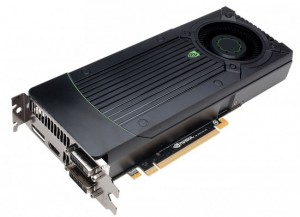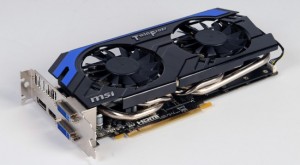NVIDIA Corporation today introduced another video card, built on the basis of 28-nanometer GPU architecture Kepler. Previously, wishing to experience the benefits of new developments Californians, it was necessary to allocate a tidy sum for the purchase of a device. NVIDIA GeForce GTX 660 Ti will be interesting to those who do not pass the sign game hits, but not willing to spend on the graphics card more than $400.

The transition to new graphics architecture, Kepler, NVIDIA started with the older models, presenting first the flagship GeForce GTX 680, and then dual-GPU GTX 690 and GTX 670. Bid for top-end solutions with a maximum price tag is ultimately proved successful – on the basis of the past quarter, the company managed to double their profits. In many ways, this contributed to an active position in the segment of NVIDIA devices for mobile solutions, but the direction of discrete graphics cards also showed growth.
However, worthy of the financial performance of the company – it is certainly good, but frankly tired of waiting for users of more affordable, yet powerful video cards based on chips with the architecture of Kepler.
NVIDIA GeForce GTX 660 Ti
In developing the NVIDIA GeForce GTX 660 Ti the company had to take into account several factors that can affect the success of the decision. On the one hand, it obviously has to be less productive than the older series adapters. It is desirable (for the developer, of course) to reduce the effects of acceleration, tuned to modifications, as well as home-overclocked video card is not too much effect on sales of high-end cards. It is obvious that the developer had to preserve the gradation of performance in their line-up, while not forgetting about potential rivals from the camp of its main competitor, presented their solutions in medium-high price segment and already there is a good foothold.
At first glance, the technical specs very much resemble those for GeForce GTX 670. In this case, uses the same graphics engine as the top solutions for NVIDIA – GK104 c 294 mm die size and 3.5 billion transistors on board. Base frequency chip containing in this case, computational units in 1344, is 915 MHz with a typical forcing with GPU Boost up to 980 MHz. This NVIDIA GeForce GTX 660 Ti card has 2GB of onboard GDDR5, which, like the older models, operating at 6008 MHz. What is the difference from the top solutions? First of all, it’s a smaller memory bus width – from 256 to 192 bits. The result is a reduction in capacity from 192 GB / S up to 144 GB / S. Obviously, this will affect the performance of graphics cards, especially in regimes with high resolution and quality settings. However, for the NVIDIA GeForce GTX 660 Ti simplification did not end there. Recall that a “full-fledged” GK104 SMX contains 8 modules, including a total of 1536 computational units. It was such chips are equipped with top-end GeForce GTX 680, while in GK104, used for GeForce GTX 670, SMX-deactivated a module with 192 stream processors. A similar modification of the chip is used for the GeForce GTX 660 Ti, but in this case a quarter of a reduced number of ROP units (ROPs) – 32 to 24, while the number of texture units (TMU) remained the same – 112. The decrease will reduce the number of blocks of ROPs fill rate and pixel rendering, which is also partly affect the overall speed video.
With regard to energy consumption, then the NVIDIA GeForce GTX 660 Ti graphics card is declared TDP at 150 watts, 20 watts less than the GTX 670. It was also below the recommended requirements for the developer of Power PSU – 450 Watts instead of 500 watts. However, to connect an additional power supply is still used two six-connector 12B. Standard interface panel will comprise two raema DVI (Dual-Link), HDMI and DisplayPort (1.2).
The special design of the PCB for the NVIDIA GeForce GTX 660 Ti is not developed. Given the use of GK104 and the similarity of the basic specifications for these adapters fit the PCB of GeForce GTX 670. Video card manufacturers, of course, will not fail to seize this opportunity. NVIDIA partners have already submitted their versions of adapters that look similar to the GeForce GTX 670.
It is interesting that among the models announced at the start, no modifications to the recommended clock speeds. Manufacturers of video cards at every opportunity using the potential of GK104 which is able to operate at frequencies much higher than 1GHz. Because without much fear as a basic set higher values.
Price
Now the important – about the price. Cost of NVIDIA GeForce GTX 660 Ti models for the reference design and recommended clock rates declared at $300. Obviously, the original model with a factory overclocked and alternative CO will differ slightly in price and are more likely to be between $300-350. In the most nimble vendors certainly have a desire to skim the cream from the first delivery? $400 is offered a high-speed GeForce GTX 670, NVIDIA GeForce GTX 660 Ti with a similar price tag will be doomed to wait on the shelves of the time when the cost will come into line recommended.
MSI N660Ti Power Edition 2GD5/OC
In the case of option “OS”, the base clock speed of the chip has been increased from 915 to 1020 MHz (11.5%) while the average value of the dynamic speed is also increased to 1098 MHz. 2 GB of GDDR5 memory running at 6008 MHz recommended (1502 MHz).
Video card is equipped with a cooler Twin Frozr IV, which is already familiar with the design of the heatsink with four heatpipes nickel (2×6 mm + 2×8 mm).
The effectiveness of the cooling system in this case, really good. Despite the fact that the forced modification of Power Edition has increased to 190 TDP Tues the cooler does an excellent job of heat dissipation. In the rest – 27 degrees and 1080 rev / min, in a difficult game mode – 61 degrees and the entire 1470 rev / min, well, FurMark able to warm up to 67 chips with all the fan speed increased to 1590 rev / min. Excellent results, especially given the fact that the level of noise emitted by the video card during operation is below average.
Acceleration
Exploring the potential of the graphics chip, it is able to further increase the core clock frequency of 50 MHz – 1020 MHz up to 1070 MHz. The memory was running stably at 7132 MHz (1783 MHz).
It is important to note that thanks to technology GPU Boost, the operating clock frequency of the chip load is almost always higher than the base. For example, when the claimed nominal 1020 MHz most of the core in games operated at 1162 MHz. And it was not short bursts and long time periods during which the technology is implemented adjust settings for maximum performance. After increasing the nominal frequency of 1020 MHz to 1070, the chip automatically are often accelerated to 1228 MHz.
The memory subsystem is perhaps not very much space, even in high-end video card NVIDIA. In the case of the NVIDIA GeForce GTX 660 Ti, reduced bus width can try to compensate by increasing the frequency. The theoretical memory bandwidth in normal mode (1502 MHz) – 144.2 GB / s, and after overclocking the memory to 1783 MHz, it increases up to 171.2 GB / s, although it is still less than the GeForce GTX 670 (192 , 3 GB / ).
The results of a single graphics card overclocking are not enough to talk about generalized potential NVIDIA GeForce GTX 660 Ti. Nevertheless, these data suggest that the new product on the GK104 has good potential for further acceleration.
The results
Guide to assess the feasibility of new items selected NVIDIA GeForce GTX 660 Ti. The level of performance in relation to that of this video card is a good indicator of the youngest features on-chip modification of GK104.
If we talk about performance NVIDIA GeForce GTX 660 Ti in the normal mode (915/6008 MHz), then, depending on the application backlog from the GTX 670 at a resolution of 1920 × 1080 pixels 5-25% (on average ~ 15-18%). The increase in clock speed can significantly reduce the gap. After the dissolution of NVIDIA GeForce GTX 660 Ti in most cases it is possible to show similar results with the GTX 670. And we must admit that it is very decent. Let’s not forget that the cost of GTX 670 starts at $400, while the recommended price of GeForce GTX 660 Ti is much lower. With the announcement of the new items you can shamelessly “release” high-end graphics card with a chip on the Fermi – GeForce GTX 580/570. Even in normal mode NVIDIA GeForce GTX 660 Ti is often an advantage. Flagman on GF110 in some cases can still compete with daring newcomer, but considering what price is given to him in all respects, it is clear that the time has come for new heroes.
Performance Comparison of direct competition from AMD and NVIDIA – traditionally a difficult task. Much depends on the used game engine features which may favor one or another graphic architecture. In the confrontation with the closest device for the price, NVIDIA GeForce GTX 660 Ti looks very good, even loyal to the GCN applications – almost par with the Radeon HD 7870 in Metro in 2033 and 8% behind in the AVP. If we consider the situation in other games and synthetic applications, the youngest model on the GK104 has the advantage even over the more expensive Radeon HD 7950.
Results
NVIDIA GeForce GTX 660 Ti leaves a good impression and decent performance at a great price. Certain simplifications, of course, affected the speed compared with older video cards on the GK104, however, comparing the bars on the charts, you need to take into account the cost of devices. NVIDIA GeForce GTX 660 Ti significantly reduces the price of entrance ticket to the world’s most modern graphics cards – fast, functional and economical. And it is very good news for those who hoped the eve of the fall of hot gaming equip your PC, spending about $300 video card.
Although AMD has made a move, recommended reducing the cost of Radeon HD 7870 up to $ 299, while the Radeon HD 7950 – up to $349, will not stop. In particular, the company intends to revise the frequency formula for the Radeon HD 7950, increasing the frequency of the GPU c 800 to 850 MHz. Moreover, the algorithm will be used Power Tune, which, depending on the nature of the load will automatically increase the frequency up to 925 MHz. The corresponding video BIOS for the reference design are available to all comers. As a result, will benefit all the fans to play in comfort, regardless of whether a video card with a chip which developer they prefer.

